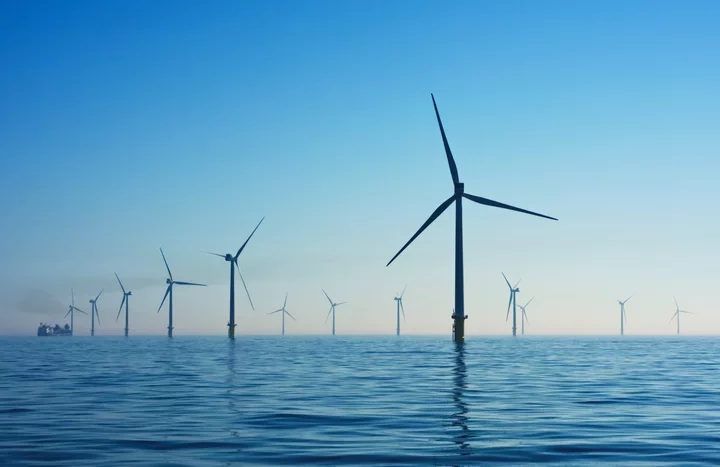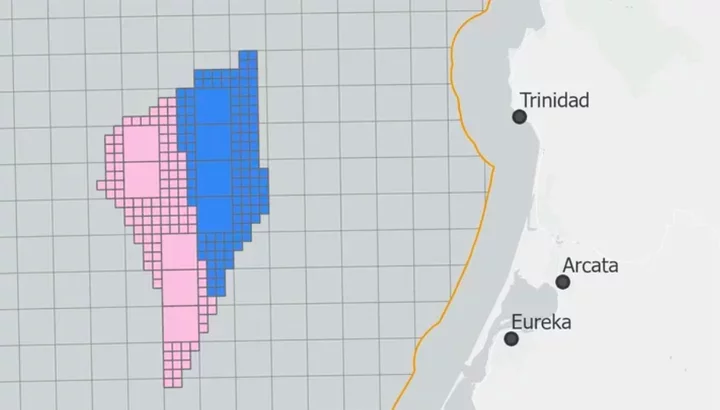Photo by Nicholas Doherty via Unsplash.
Let the bidding begin!
Thousands of acres of ocean real estate will be up for grabs during the first-ever offshore wind lease auction on the West Coast. Beginning Tuesday morning, the Bureau of Energy Ocean Management (BOEM) will auction off five leases – three off Morro Bay and two off Humboldt Bay – for the development of floating offshore wind energy facilities.
Forty-three separate entities, ranging from regional LLCs all the way up to energy giants like Shell, have qualified as potential bidders for the five lease areas.
Here’s how the bidding process works:
Bidders will hop online for the monetary auction at 7 a.m. PST. All five lease areas – comprising over 373,000 acres and up to 4.5 gigawatts of capacity – will be offered up in a single auction. Each lease area has its own minimum bid requirement, ranging from $6.3 million to $8 million. “Each bidder may only bid for one of the offered Lease Areas at a time and, ultimately, acquire only one of the Lease Areas in the auction,” as noted in the Final Sales Notice (FSN).
The Humboldt Wind Energy Area (WEA) spans more than 200 square miles – 28 miles north to south and about 14 miles east to west – roughly 20 miles west of Eureka. Map: BOEM
Bidding will go in rounds until there are no new “live bids.” If bids are still coming in by the end of the day, the auction will continue on Wednesday. Once bidding ends, BOEM will determine the “provisionally winning bid” for each lease area.
Once the provisional winners have been announced, BOEM will return the non-winners’ bid deposits and the Department of Justice will conduct an antitrust review of the auction. All winners are considered provisional until they sign the lease, provide financial assurance and pay any outstanding balance of their bid.
As soon as those requirements have been met, the lease will be executed and the leaseholder will begin the planning process early next year.
Lost Coast Wind, a newly formed coalition of local tribal and environmental consultants, hopes to ensure a successful wind energy future for the North Coast by building “meaningful, impactful partnerships between local Native Americans and wind developers.”
“We want to make sure that, as wind energy resources are developed here, it is being done in a fair and equitable way,” Craig Tucker, principal for Lost Coast Wind, told the Outpost. “We’re working with the Yurok Tribe and they have a lot of concerns. … I think the Yurok Tribe, and other local tribes, are going to be very interested in whoever steps forward as a developer. I think developers would be wise to start collaborating with local tribes as soon as possible to make sure that their impacts on tribal resources, cultural resources and natural resources are immediately addressed.”
To mitigate potential impacts, BOEM offers developers a little something called a bid credit package. To qualify for the credit package the bidder “must commit to mak[ing] a qualifying monetary contribution to programs or initiatives” that benefit the greater Humboldt County community, according to the FSN for the Humboldt Wind Energy Area (WEA). Up to 30 percent of the final cash bid that is accepted for each lease area during the upcoming auction could be set aside to offset local impacts to tribes, fisheries and other Humboldt Bay communities.
“Someone’s gonna pay a lot of money – probably hundreds of millions of dollars – for the rights to lease the ocean to develop a wind project, and instead of all that money sort of disappearing back into the Department of the Treasury, some of that bid could be invested locally,” Tucker explained. “That could include different community benefits, investing into the fishing industry to help solve some of the conflicts they may have with offshore wind, or investment in the local workforce so folks living here can have access to the skills that this industry needs.”
However, the bid credit is not guaranteed. Bidders can choose to opt out of the credit on the Bidder’s Financial Form.
Whether or not the bidders choose to opt into the bid credit package remains to be seen. “It will really take a few weeks to spell it all out,” Tucker said.
Speaking on behalf of the Blue Lake Rancheria, Councilmember Jason Ramos emphasized the need for an expedited “transition to clean technologies and low carbon solutions” for North Coast communities.
“Bringing offshore wind to the North Coast region is a tremendous opportunity for Humboldt County to lead by example, and take a progressive step forward toward sustainable living,” Ramos told the Outpost. “The move would support meaningful industry growth that will bring in new good-paying jobs and spur positive economic growth, along with safeguards to ensure the region is not exploited. Tribes are currently exploring ways to lead on these energy projects, by supporting needed workforce development, supply chains, as well as operations and maintenance needs of the wind turbines.”
[DISCLOSURE: The Blue Lake Rancheria is a minority owner in the Outpost’s parent company, Lost Coast Communications, Inc.]
Wiyot Tribal Chair Ted Hernandez told the Outpost that the matter has yet to be discussed by the tribal council and declined to offer further comment on the subject for the time being.
Want to learn more about offshore wind energy? In the video below, friend of the Outpost and Arcata News reporter Eric Black takes a look at how the Humboldt WEA would tie into transmission infrastructure throughout the region to bring renewable energy to the North Coast and beyond.
###
DOCUMENTS:
PREVIOUSLY:
- Biden Administration Proposes Offshore Wind Lease Sale, Including Two Spots Off the Humboldt County Coast
- IT’S ON: Humboldt Offshore Wind Leases to Go Up For Auction on Dec. 6
- Harbor District Announces Massive Offshore Wind Partnership; Project Would Lead to an 86-Acre Redevelopment of Old Pulp Mill Site
- Offshore Wind is Coming to the North Coast. What’s in it For Humboldt?
- North Coast Fishermen Fear for the Future of Commercial Fisheries as Offshore Wind Efforts Advance


CLICK TO MANAGE